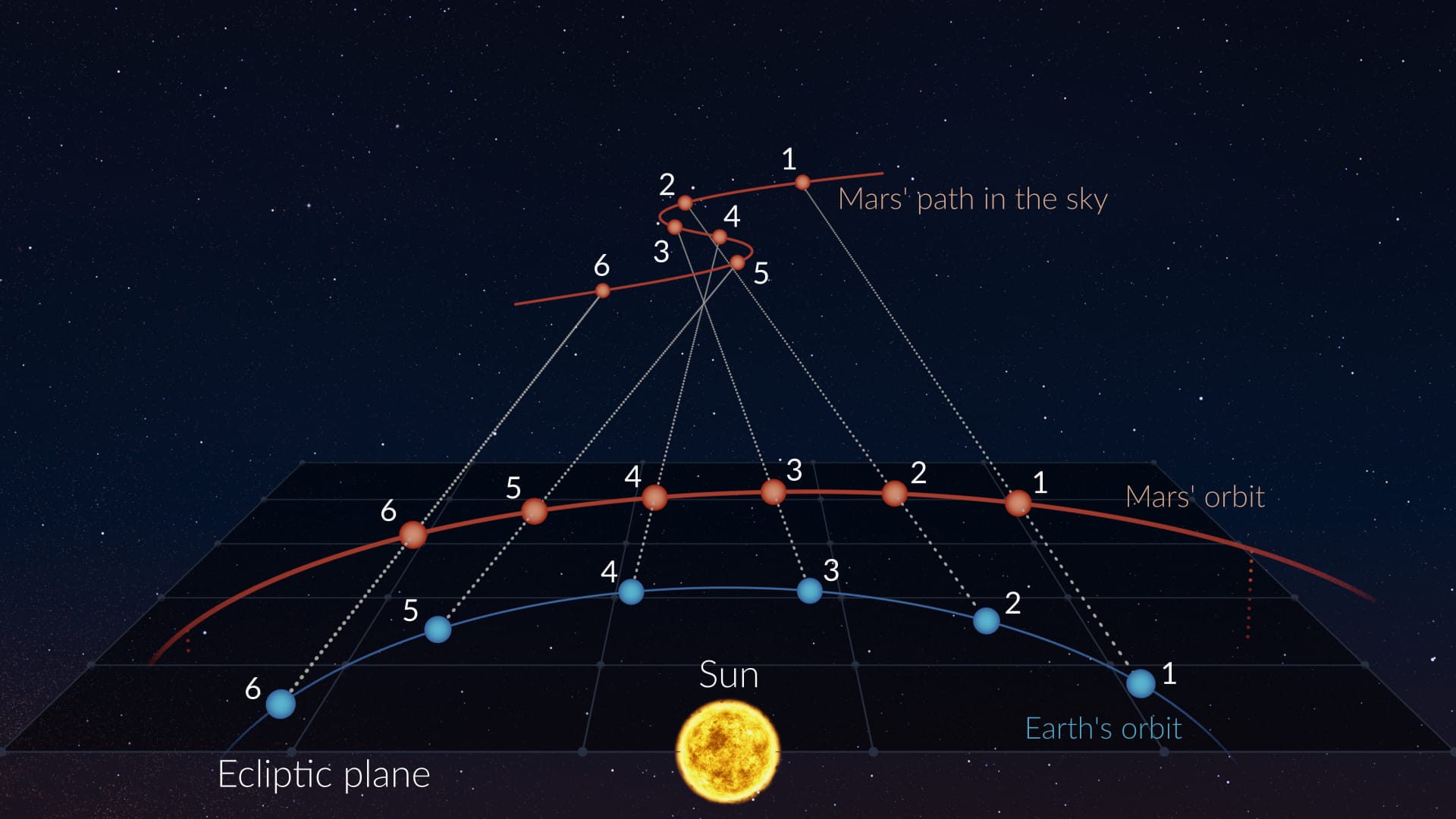Retrograde Motion Explained: What Is Retrograde Motion in Astronomy
Why do planets sometimes seem to move “backward”? Is such a motion even real? Should you fear Mercury retrograde? Here, we’ll explain the celestial mechanics behind the retrograde motion and show you how to see it with Sky Tonight.
Contents
- What does it mean when a planet is retrograde?
- What causes the apparent retrograde motion of the planets?
- What is in retrograde right now?
- Retrograde planets in 2026
- How to see the retrograde motion: retrograde loops
- How do planets in retrograde affect us?
- Retrograde motion of planets: to sum up
What does it mean when a planet is retrograde?
When a planet seems to reverse its direction in the sky, it’s called retrograde motion (from the Latin word retrogradus – "going backward").
Day to day and week to week, as the Earth revolves around the Sun, the planets usually drift from west to east against the background of stars. Astronomers call it direct or prograde motion. This motion shouldn’t be confused with the daily motion of the planets and the Sun in the sky, which goes from east to west and is caused by the Earth’s rotation on its axis.
At specific periods of time, a planet can start moving “backward” – from east to west. This westward movement is called apparent retrograde motion.
What causes the apparent retrograde motion of the planets?
The apparent retrograde motion is caused by differences in the planets’ orbital speed.
Let's use Mars as an example. Mars is a superior planet, meaning its orbit is farther from the Sun than Earth's. Because of this, Mars moves more slowly in its orbit than Earth. When we pass Mars, it seems to be moving “backward” because we're moving faster than it is. The same thing happens when you pass by a slower-moving car on the highway – for a moment, it appears to move in the opposite direction.

This mechanism works for all the superior planets. The inferior planets, Mercury and Venus, orbit closer to the Sun than Earth and therefore move faster along their paths. They also periodically appear to move “backward”. However, during retrograde motion, inferior planets are positioned near the Sun in the sky. Mercury is often completely lost in the Sun’s glare, while Venus can still be observed around sunrise or sunset.

Ancient astronomers were rather puzzled by the retrograde motion phenomenon – especially those who thought that the Earth was at the center of the Universe. Only in the 16th century did Nicolaus Copernicus introduce his heliocentric model and explain retrograde motion as an apparent effect. Initially, his idea faced resistance, but it was later accepted and became the foundation of modern astronomy.
What is in retrograde right now?
The following planets are currently in retrograde motion:
Retrograde planets in 2026
The following planets will go retrograde in 2026:
- Mercury: February 25, 2026 – March 19, 2026; June 29, 2026 – July 23, 2026; October 24, 2026 – November 13, 2026
- Neptune: July 7, 2026 – December 13, 2026
- Saturn: July 27, 2026 – December 11, 2026
- Uranus: September 10, 2026 – February 8, 2027
- Venus: October 2, 2026 – November 11, 2026
- Jupiter: December 13, 2026 – April 13, 2027
Mars is the only planet that won't go retrograde in 2026. Its retrograde period begins on January 11, 2027, and ends on April 2, 2027.

How to see the retrograde motion: retrograde loops
To observe retrograde motion, record a planet’s position in the sky at the same time each day. Over the course of several weeks, these marks will gradually reveal the retrograde loop that the planet traces.

You can do this manually (but it'll take at least several weeks) or you can do it in 3 steps with the stargazing app Sky Tonight. It has a special feature that allows you to instantly build a curve showing the annual movement of any planet. Here’s how to see the retrograde motion of a planet via Sky Tonight:

- Tap the magnifier icon at the bottom of the screen and type the name of a planet (e.g., Mercury) into the search field;
- Tap the blue target icon opposite the name of the planet and see its current position on the sky map;
- Tap the small white camera icon at the bottom part of the screen to enable the curve-building feature. You’ll see the path the planet passes in the sky over several months and will be able to clearly see how the planet “changes direction” at certain moments.
How do planets in retrograde affect us?
Astrologers may warn you against signing contracts during Mercury retrograde or buying metal tools during Mars retrograde. It’s your choice to believe them or not.
However, you now know that retrograde motion is just an illusion that can’t possibly affect your everyday life – at least from the scientific point of view.
A celestial body that can really affect our lives is an asteroid heading to our home planet. Learn when the next asteroid will hit Earth and what we can do about it.
Retrograde motion of planets: to sum up
Retrograde motion is an apparent reversal of the planetary movement. From the Earth, it appears that the planets in the sky are moving “backwards” at certain times. We hope that we’ve managed to explain the nature of the retrograde motion phenomenon to you. If you liked the article, please share it with your friends! Also, get Sky Tonight to easily track any planet in the sky.
Still have questions? Watch our video showing retrograde motion of Mercury and see what happens to the planet in space versus how it looks in our sky.
For more interesting facts about retrograde motion, have a look at our dedicated infographic!

